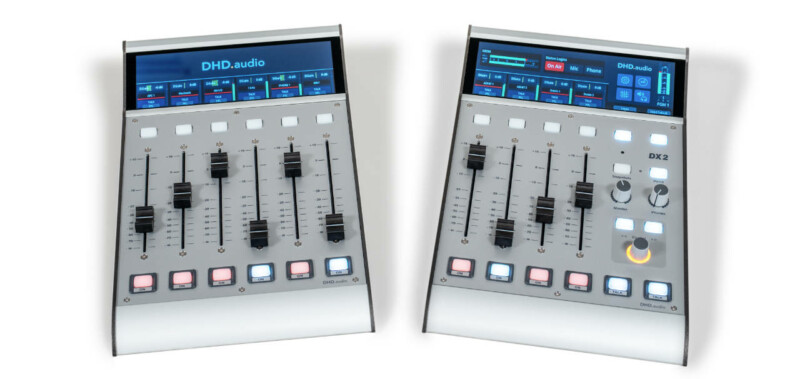Making its IBC 2022 debut on stand 8.B81 will be DX2 compact desktop audio mixer which is designed for use wherever space is at a premium.
Applications include video editing booths, news commentary suites, OB trucks and podcast studios.
“The DX2 is a physically compact mixer offering the user-friendly features of the established DHD mixer range to ensure easy on-air operation as well as offline,” says Christoph Gottert, DHD’s Head of International Sales. “It is based on the 52-1214A four-fader central module plus the 52-1220A six-fader expansion unit, both of which are robustly built to withstand round-the-clock operation. The maximum number of faders is determined by the capabilities of the connected core.”
Four faders plus a dedicated section for setup, monitoring, and talkback are incorporated in the 52-1214A central module. Connectivity features include a broadcast quality XLR microphone input, right and left line outputs to feed active loudspeakers, a 6.3 mm jack stereo headphone output plus a 3.5 mm mini jack input port which allows direct audio insertion from a smartphone for live telephone interviews.
The 52-1220A fader module has six professional grade 100 mm motorised faders with dust-protection. Each channel incorporates 100 mm motorised faders, two control buttons, a UTF8-supported channel identifier, adjustable gain settings, an input channel meter, plus programme/off-air selection. Each fader can support a second layer. Dedicated potentiometers are provided for headphone and loudspeaker level.
Both DX2 modules are equipped with a user-configurable 7.8 inch multi-touch screen for viewing fader and central control parameters. Optional Assist App 52-8512 can be used to control the mixer via a 1:1 copy directly from any browser. The DX2 can be connected to all DHD XC3 and XD3 cores. It integrates easily with Series 52 I/O modules such as the Dante or AES67 AoIP interfaces, 3G/HD SDI embedder/de-embedder, MADI or DHD APC audio.
Also making their IBC debut will be the latest additions to DHD’s range of audio production processing cores. These integrate elements such as control surfaces, routing and external-device interfacing into a stand-alone or distributed system. The new XC3 and XD3 provide full support for intra-site as well as multi-site IP-based device control and audio-over-IP signal distribution. Automated workflows and product virtualisation are fully supported.
The DHD XC3 IP core is designed for use in on-air studios. It comprises two dual-core DSP modules which combine into a compact 1U. These jointly support up to 48 stereo faders, 72 stereo busses and 16 channels of AES67 IP audio. IPx expansion modules can be added to accommodate 128 channels of AES67/Ravenna IP audio in/out and up to 512 Dante channels. A companion module, the XC3 Concentrator, allows easy interconnection of multiple DHD IPx modules, control surfaces and I/O modules.
The XD3 is a high-performance IP core for use with large mixing and routing systems. It includes support for demanding networked operations such as DHD web apps. The XD3 IP core allows fully redundant configuration and can accommodate an optional router. Up to 96 stereo faders, 126 stereo busses and 24 Gigabit Ethernet audio ports are supported by the XD3 router and IP core combination.
DHD’s latest-generation Version 10 firmware gets its first IBC showing. This offers new capabilities including enhanced security, unified user management based on web apps, expanded fader and bus handling, and refinements to the DHD Toolbox configuration software. Security and management feature additions range from a powerful new onboarding sequence for initial setup plus EBU security measures for media nodes.









